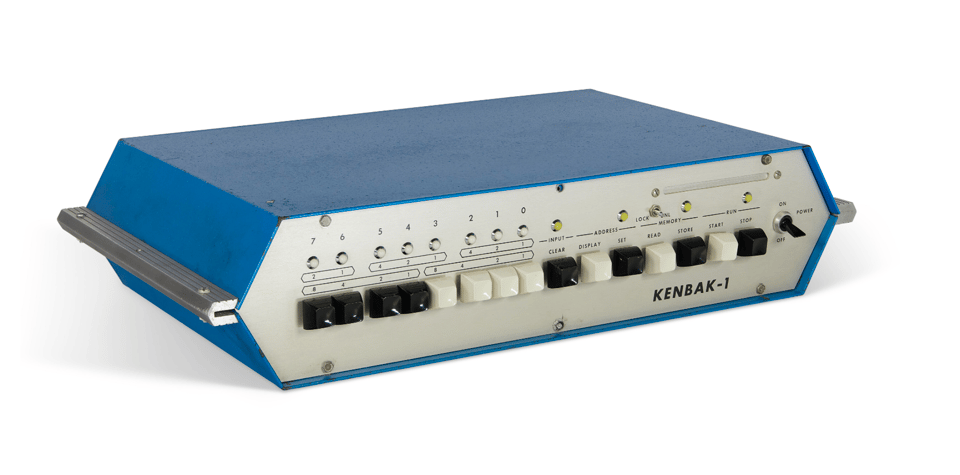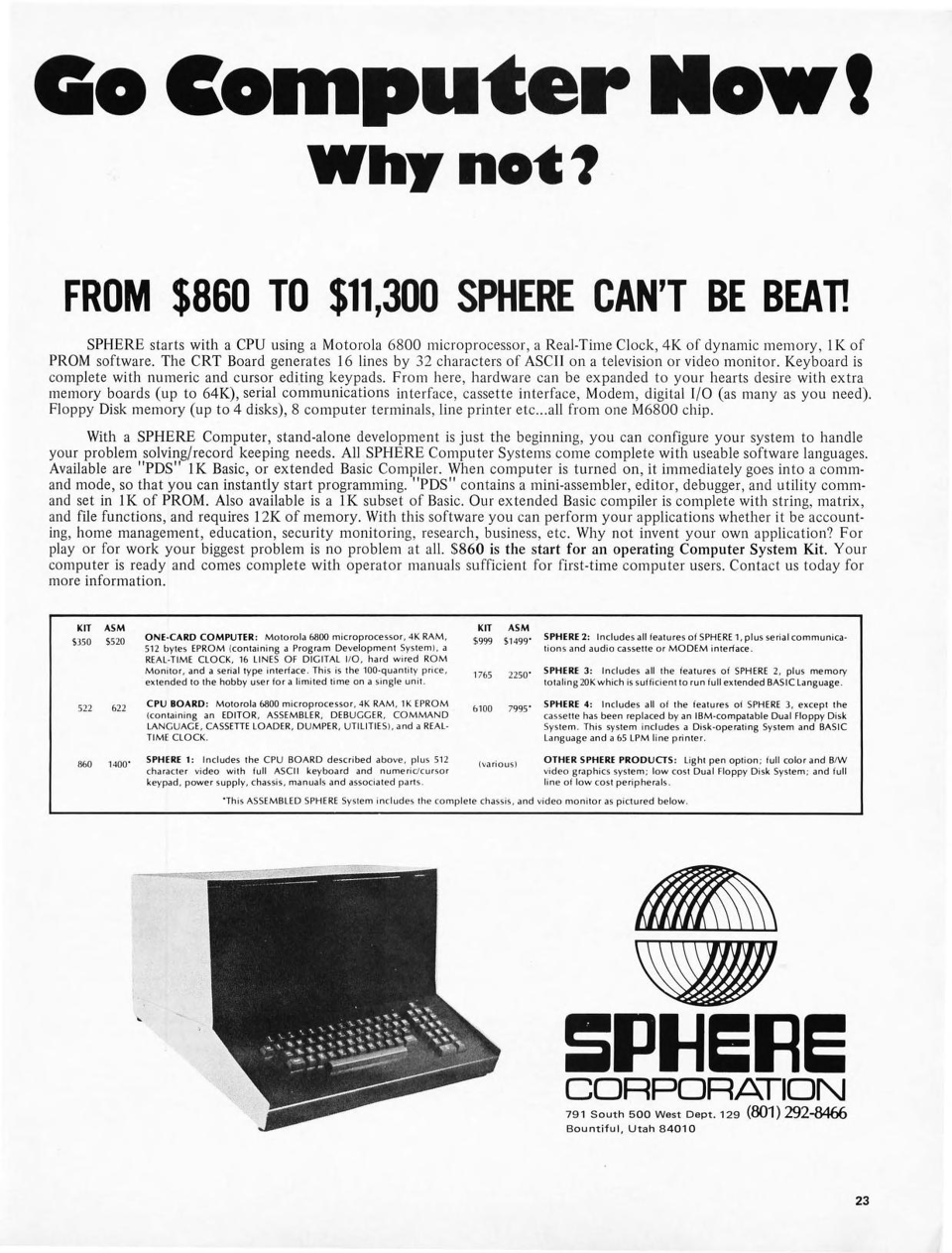Go Computer Now! ..and The Road to Sphere #1
Quick book update and the stories of Kenbak and Datapoint.
Hello! A quick book update: I put up a small minisite and Kickstarter pre-launch page. Besides telling you fine folks about this, I’m not spreading the word much until the crowdfunding campaign launches in early Fall.
The book has the title Go Computer Now! How Sphere Corporation Invented the Modern Microcomputer… Then Disappeared. Here is a (not-final) cover mockup:

The main title—“Go Computer Now!”—comes from a full-page Sphere advertisement that appeared in the January 1976 issue of Byte magazine. Throughout this project I’ve kept coming back to the enthusiasm in that quirky little phrase, which feels like such a great fit for a company that was a little rough around the edges but all-in at a moment of change and urgency. The book’s (tentative?) subtitle is intentionally a bit provocative. Litigating “firsts” in computer history is a mug’s game, but I do attempt to make the case for Sphere as important and special in its time, as well as explain its rise then fall into obscurity.
I will be using Kickstarter to fund the production and print run for the book. If you have a Kickstarter account, do feel free to go click “Notify me” on that page.
The Road to Sphere #1: Precursors to the Micros
But now, some more computer history! This is the first in a series of (probably) three posts about the “road to Sphere,” which is really to say the precursors to commercially successful microcomputers. This is material that I dropped from the book because the level of detail ultimately wasn’t core to the Sphere story.
The rise and fall of Sphere Corp occurred neatly within the protean “early microcomputer” era of 1975-77. But there was a prehistory, a few sparks that appeared here and there as diverse people and companies recognized the potential in “personal” (single-user) computing.
What the sparks led to, of course, was the MITS Altair in January of 1975, the first meaningfully successful microcomputer of any kind. Once the stars and technology aligned, Sphere, IMSAI, Processor Technology and others jumped into the arena.
But for now, let’s take a look at some of the interesting waypoints before the Altair, starting at the dawn of the 1970s. What were these strange beasts, and what do they tell us about what was to come later?
Kenbak
John Blankenbaker spent twenty years dreaming of a computer for his own use, at first to help him solve his tedious physics exercises at Oregon State where he was a student. That was 1949, when the only computers that existed were vacuum tube behemoths. But how they worked fascinated Blankenbaker, and subsequent jobs at the National Bureau of Standards and Hughes Aircraft exposed him directly to the big (but shrinking) machines and kept him dreaming.
Blankenbaker was between jobs in 1970 when he finally made a real attempt at putting together a computer for individual use. His goals for such a machine were that it be “low cost, educational, and able to give the user satisfaction with simple programs.” What he was able to create was remarkable— Blankenbaker built a small bespoke computer out of off-the-shelf logic chips. There was no microprocessor inside; Intel hadn’t yet announced their 4004, the first true single-chip CPU. Blankenbaker encased the machine in a short and wide cabinet of 20 gauge blue steel. The sides were swept into bracketed angles—it looked like science fiction—and along its narrow front panel were a series of buttons and lights for input and output.

Blankenbaker named his computer Kenbak-1, extracting that word from the middle of his own surname. He liked that it seemed to echo “Kodak,” a legendary brand. Later, he wrote: “My wife warned me that there would be a spelling problem, but I thought that if people could learn to spell Kodak, then they could learn to spell Kenbak.” (He admitted that his wife turned out to be correct.) Blankenbaker began advertising the computer for $750 (about $6,000 in 2025).
He marketed Kenbak-1 as a “trainer,” that is, an easy way to get exposure to how a computer worked, for students and engineers. The technical acumen of the design, a culmination of Blankenbaker’s decades of mulling on the problem, was notable. As a product, it was a failure: Blankenbaker leaned into the education market where the machine was well-received—one teacher raved that “concepts that we had only talked about came alive” for students—but the purchase cycles were lengthy.
Only 50 or so units were sold, starting in September of 1971, and the Kenbak-1 came and went in near-total obscurity. Outside of a couple references in Fred Gruenberger’s niche Popular Computing newsletter, it went unnoticed by the entire early microcomputing world.
But that changed in 1986 when Blankenbaker submitted his invention to a “contest” held by The Computer Museum in Boston to crown the earliest personal computer. The Kenbak-1 won top prize, infuriating Altair inventor Ed Roberts and elevating the Kenbak-1 to the pantheon of important computing devices. Its legend has only grown since, and the example pictured above sold for over $100,000 at auction last year.
Was the Kenbak-1 really the first personal computer? The designation makes sense if you read both “personal” and “computer” with their most literal respective meanings, but probably says more about how history is constructed than about the device itself. The Kenbak-1 as a product is best understood as a toy minicomputer, made possible by falling semiconductor costs and old-fashioned individual ingenuity. In any case, it is an undoubtedly fascinating artifact, and a signpost on the road to more consequential things.
Datapoint

Unlike Blankenbaker, other early “small” computer manufacturers were trying to sell to corporate customers at very corporate prices. The first of these was intimately tied to the development of Intel’s 8008 microprocessor. This was the Datapoint 2200 from Computer Terminal Corporation (CTC) of San Antonio, Texas.
CTC inked a deal with Intel to produce a chipset that would support their proposed system’s instruction set. Intel was late to deliver, and CTC cut ties with the Santa Clara startup. Intel went on to finalize and package this work as their first 8-bit microprocessor, marketed under the part number 8008. (Intel had also recently launched a 4-bit calculator chipset, led by the 4004 microprocessor, widely acknowledged to be the world’s first such integrated circuit, but not suitable for general purpose computing.)
In San Antonio, Phil Ray and Gus Roche of CTC pressed ahead with their Datapoint 2200, designing the system with a large number of other logic chips to do the same job. Because the machine did not use a microprocessor, it was not a “microcomputer” in the strict sense at all. But in this case it’s a distinction without a difference: like twins separated at birth, the Datapoint 2200’s programming model was identical to the Intel 8008’s, and you wouldn’t know the difference without breaking the machine open. CTC referred to the Datapoint 2200 as a “programmable terminal.”
In appearance, the Datapoint computer was a low-slung, self-contained desktop unit, mostly beige but dark brown on its curving front panel. It had the footprint and rough shape of an IBM Selectric typewriter, which was intentional. The built-in monitor was a half-height CRT display—a costly custom component—to keep the overall device compact and approachable. Emerging from the back was just a single cable, for wall power.
“People liked the looks of it,” remembered CTC sales executive Gerry Cullen. “It was sexy. There was no big screen, no boxes, and no flashing lights or glowing tubes. It looked really friendly and did not look like it needed a scientist to run it. It looked like a fancy typewriter that anyone could use—like an office appliance.”
To an extent, CTC undersold the computer, not quite grasping that they had created something more useful than they knew. Salesman Dave Gust explained that “the original idea was that we, CTC, would come up with some canned programs like terminal emulators"—programs that would be loaded from the built-in data cassette decks mounted flush into the top of the unit, to enable the computer to connect to various different mainframes and minicomputers. "The buyers would use the tape cassettes for data collection. That they might go beyond the canned programs had not occurred to CTC at that time. The thought had not entered their minds to give the user the capability of sitting down and writing programs and doing things on their own."
Customers, however, understood. They derailed the sales engineering seminars, insisting on information about how to write their own business software.
The first Datapoint 2200 went into service in March of 1971, at Pillsbury headquarters in Chicago. Other units were installed at four of their chicken farms, starting in El Dorado, Arkansas. Pillsbury engineers wrote software in direct machine code to accumulate data locally, and then every so often they could dump the data to a cassette and send it by mail it to headquarters. It was a mix of the brand new and the old-fashioned, and it worked.
CTC (which soon renamed itself Datapoint after its flagship products) had accidentally struck a vein of value, which they were only partially able to mine in the coming years. The computers were very expensive: starting at $6,000 or so, with some configurations exceeding $10,000 (over $80,000 today). They were built around the same cost and sales structure as the big old-line computers: many systems were leased rather than purchased, since that was how corporations were used to dealing with computing equipment from IBM and others. The customers were necessarily corporate.
It’s not a coincidence that both the Kenbak and Datapoint computers were 8-bit systems, as were pretty much all single user systems from that point forward, including the Sphere. That describes the number of bits in the primary internal registers of the system, which is where the current working data is stored while the computer does its computing. Eight bits is a nice number. Among other benefits, it’s enough to store text characters, meaning that you can work with language without much extra fuss. Big mainframes and minicomputer designs used a wide array of bit widths, but the first popular microprocessors were all pretty much 8-bit machines. Intel’s 4004 was a 4-bit processor, which wasn’t a problem for the calculators it was designed to inhabit, but no one seems to have had the temerity to try to build a computer around that.
Intel’s 8008 was launched as a general microprocessor in early 1972—a year after the first Datapoint 2200 went into service—and became the centerpiece of many prehistoric microcomputers… stay tuned for the next installment and more interesting 8008 gems.
You can always reach me at bzotto@gmail.com. The main site for this project is at https://sphere.computer. All text is copyrighted by Ben Zotto. Thanks for reading.
Go Computer Now,
Ben Z

Sources:
Lamont Wood. Datapoint: The Lost Story of the Texans Who Invented the Personal Computer Revolution. Hugo House Publishers, 2010.
Datapoint 2200 Prices, July 1972.
Tim Jackson. Inside Intel: Andy Grove and the Rise of the World’s Most Powerful Chip Company. Plume, 1997.
Michael S. Malone. The Microprocessor: A Biography. Springer-Verlag TELOS, 1995.
John Blankenbaker, kenbak-1.net personal site.
Various resources at kenbak.com
“Kenbak-1” in Personal Computing, May 1973 Vol 1 No. 2, p12.
Auction results from “Firsts: The History of Computing From the Paul G. Allen Collection,” Christie’s, Sept 12, 2024.
